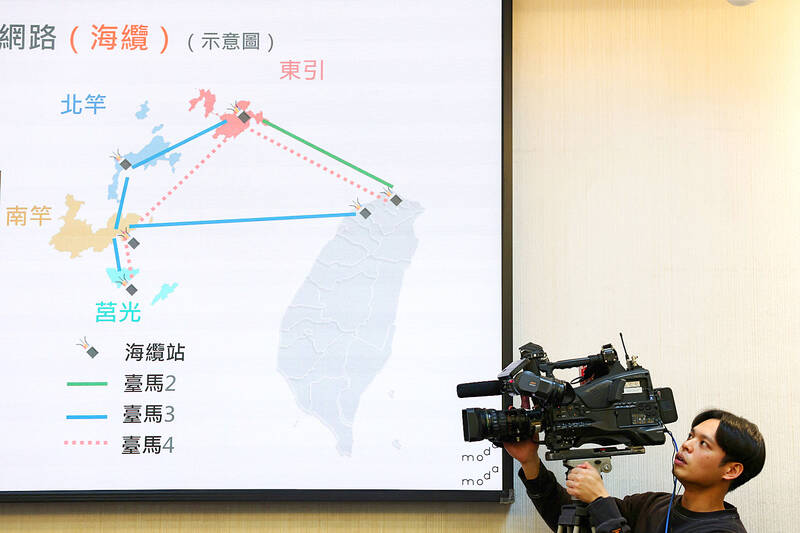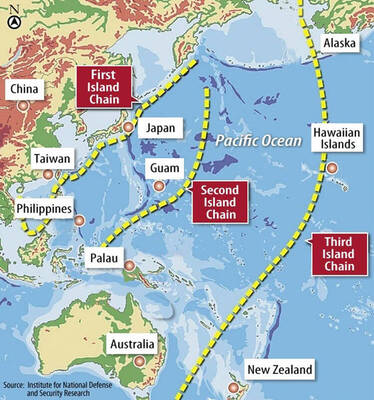Chunghwa Telecom Co (中華電信) immediately switched to a microwave backup system to maintain communications between Taiwan proper and Lienchiang County (Matsu) after two undersea cables malfunctioned due to natural deterioration, the Ministry of Digital Affairs told an emergency news conference yesterday morning.
Two submarine cables connecting Taiwan proper and the outlying county — the No. 2 and No. 3 Taiwan-Matsu cables — were disconnected early yesterday morning and on Wednesday last week respectively, the nation’s largest telecom said.
“After receiving the report that the No. 2 cable had failed, the ministry asked Chunghwa Telecom to immediately activate a microwave backup system, with the procedure completed within an hour,” Deputy Minister of Digital Affairs Chiueh Her-ming (闕河鳴) said.

Photo: Ann Wang, Reuters
“The microwave system can provide a maximum bandwidth of 12.6 gigabits per second [Gbps], which is higher than Matsu’s peak traffic volume of 9.5Gbps on weekdays and 8Gbps during the Lunar New Year holiday,” Chiueh said.
Government agencies, banks and hospitals in Lienchiang County would have priority access to ensure the continuation of services to residents on the islands, he said.
The ministry has installed in the county eight low-Earth orbit satellite dishes and one medium-Earth orbit satellite dish as backup to the microwave system, he said.
Chiueh ruled out that the cables were damaged by ships.
The cables malfunctioned because of natural deterioration, he said, adding that both should be fixed by the end of next month, if weather and sea conditions permit.
A temporary measure using spare core wires has re-established connection via the No. 2 cable, Chunghwa Telecom said.
It switched services from the microwave system back to the No. 2 cable at 11:40am yesterday, it said.
“As cables deteriorate, core wires snap in progression along the cable, which does not happen if they are hit by an anchor dragged by a ship or severed by other human-caused means,” he said.
“If damage to a cable is caused by human activity, there is no telling how long it would take to fix,” he said.
Chunghwa Telecom said that the No. 3 cable was disconnected on Wednesday last week, possibly because of natural deterioration, as well as a strong current.
It switched services to the No. 2 cable and activated a microwave backup system, it said.
There were no signs that human activity was involved in the No. 3 cable being disconnected, with no ships in the area showing suspicious behavior, it said.
It would send an alert via the automatic identification system to ships entering areas near submarine cables to leave the area immediately, and to refrain from dropping anchor or fishing.
The Coast Guard Administration in a statement said that it had reviewed radar data from Wednesday last week and early yesterday morning, finding no evidence of suspicious behavior by ships.
It has relayed the information to Chunghwa Telecom, it added.
Taiwan has recorded four issues with submarine cables this month alone, compared with three incidents in the whole of last year and three in 2023, Chiueh said.
“There has been an increase in incidents of submarine cables being cut by fishing boat and freighter activity in the past two years,” he said. “As such, the Executive Yuan has listed 10 domestic submarine cables as key infrastructure, including the ones connecting Taiwan and Lienchiang. They would be maintained using government resources.”
The ministry is to help fund a fourth submarine cable to be built by Chunghwa Telecom, with work to be completed by June next year, he said.
International cables were built by multiple stakeholders in Taiwan and overseas, with maintenance costs being shared among them, Department of Communications and Cyberresilience Director-General Niu Hsin-ren (牛信仁) said.
Deputy Minister of Digital Affairs Lin Yi-jing (林宜敬) said that the ministry had budgeted NT$530 million (US$16.17 million) to shore up Taiwan’s digital resilience by building non-synchronous orbit satellite communications networks, submarine cable landing stations and a microwave communications network.
However, about 56 percent of the funding has been eliminated because of a comprehensive budget cut by the Legislative Yuan, Lin said.

The US government has signed defense cooperation agreements with Japan and the Philippines to boost the deterrence capabilities of countries in the first island chain, a report by the National Security Bureau (NSB) showed. The main countries on the first island chain include the two nations and Taiwan. The bureau is to present the report at a meeting of the legislature’s Foreign Affairs and National Defense Committee tomorrow. The US military has deployed Typhon missile systems to Japan’s Yamaguchi Prefecture and Zambales province in the Philippines during their joint military exercises. It has also installed NMESIS anti-ship systems in Japan’s Okinawa

‘WIN-WIN’: The Philippines, and central and eastern European countries are important potential drone cooperation partners, Minister of Foreign Affairs Lin Chia-lung said Minister of Foreign Affairs Lin Chia-lung (林佳龍) in an interview published yesterday confirmed that there are joint ventures between Taiwan and Poland in the drone industry. Lin made the remark in an exclusive interview with the Chinese-language Liberty Times (the Taipei Times’ sister paper). The government-backed Taiwan Excellence Drone International Business Opportunities Alliance and the Polish Chamber of Unmanned Systems on Wednesday last week signed a memorandum of understanding in Poland to develop a “non-China” supply chain for drones and work together on key technologies. Asked if Taiwan prioritized Poland among central and eastern European countries in drone collaboration, Lin

BACK TO WORK? Prosecutors said they are considering filing an appeal, while the Hsinchu City Government said it has applied for Ann Kao’s reinstatement as mayor The High Court yesterday found suspended Hsinchu mayor Ann Kao (高虹安) not guilty of embezzling assistant fees, reducing her sentence to six months in prison commutable to a fine from seven years and four months. The verdict acquitted Kao of the corruption charge, but found her guilty of causing a public official to commit document forgery. The High Prosecutors’ Office said it is reviewing the ruling and considering whether to file an appeal. The Taipei District Court in July last year sentenced Kao to seven years and four months in prison, along with a four-year deprivation of civil rights, for contravening the Anti-Corruption

NO CONFIDENCE MOTION? The premier said that being toppled by the legislature for defending the Constitution would be a democratic badge of honor for him Premier Cho Jung-tai (卓榮泰) yesterday announced that the Cabinet would not countersign the amendments to the local revenue-sharing law passed by the Legislative Yuan last month. Cho said the decision not to countersign the amendments to the Act Governing the Allocation of Government Revenues and Expenditures (財政收支劃分法) was made in accordance with the Constitution. “The decision aims to safeguard our Constitution,” he said. The Constitution stipulates the president shall, in accordance with law, promulgate laws and issue mandates with the countersignature of the head of the Executive Yuan, or with the countersignatures of both the head of the Executive Yuan and ministers or